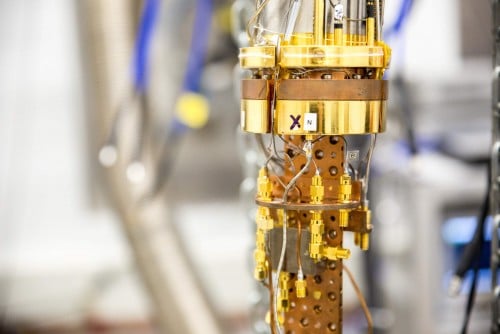Science
Time Crystals Pave the Way for Advanced Quantum Computing

Researchers at Aalto University have made a groundbreaking advancement in quantum technology by successfully connecting a time crystal to an external system. This innovative process could significantly enhance the computational and sensing capabilities of future quantum computers. The findings were published in the journal Nature Communications on October 16, 2023.
Time crystals represent a unique class of quantum systems that maintain a perpetual motion without requiring external energy input. First theorized by Frank Wilczek, a Nobel Laureate in Physics in 2012, time crystals have a repeating structure in time rather than space. They were experimentally confirmed to exist in 2016, but this recent study marks the first instance where researchers connected a time crystal to another system.
Academy Research Fellow Jere Mäkinen led the study, which involved transforming a time crystal into an optomechanical system. The researchers employed radio waves to introduce magnons into a superfluid Helium-3, cooled to near absolute zero. Magnons are quasiparticles that act collectively as individual particles. Remarkably, when the radio waves were turned off, the magnons formed a time crystal that remained in motion for up to 10^8 cycles, equating to several minutes.
During this process, the time crystal established a connection with a nearby mechanical oscillator, influenced by the oscillator’s frequency and amplitude. Mäkinen elaborated on the significance of these findings, stating, “We showed that changes in the time crystal’s frequency are completely analogous to optomechanical phenomena widely known in physics. These are the same phenomena that are used, for example, in detecting gravitational waves at the Laser Interferometer Gravitational-Wave Observatory in the U.S.”
The implications of this research are substantial. Time crystals could dramatically extend the lifespan of quantum systems, which are currently limited in duration. Mäkinen explained, “Time crystals last for orders of magnitude longer than the quantum systems currently used in quantum computing. The best-case scenario is that time crystals could power the memory systems of quantum computers to significantly improve them.”
Additionally, time crystals can serve as frequency combs, referenced in high-sensitivity measurement devices. These developments highlight the potential for time crystals to enhance the performance and reliability of quantum technologies.
The research utilized the facilities of the Low Temperature Laboratory, part of OtaNano, which serves as Finland’s national research infrastructure for nano-, micro-, and quantum technologies. The computational support came from the Aalto Science-IT project, underscoring the collaborative effort behind this significant advancement in quantum physics.
As researchers continue to explore the possibilities of time crystals, their role in the evolution of quantum computing and sensing technologies appears increasingly promising.
-

 Science2 months ago
Science2 months agoInventor Achieves Breakthrough with 2 Billion FPS Laser Video
-

 Health2 months ago
Health2 months agoCommunity Unites for 7th Annual Into the Light Walk for Mental Health
-

 Top Stories2 months ago
Top Stories2 months agoCharlie Sheen’s New Romance: ‘Glowing’ with Younger Partner
-

 Entertainment2 months ago
Entertainment2 months agoDua Lipa Aces GCSE Spanish, Sparks Super Bowl Buzz with Fans
-

 Health2 months ago
Health2 months agoCurium Group, PeptiDream, and PDRadiopharma Launch Key Cancer Trial
-

 Top Stories2 months ago
Top Stories2 months agoFormer Mozilla CMO Launches AI-Driven Cannabis Cocktail Brand Fast
-

 Entertainment2 months ago
Entertainment2 months agoMother Fights to Reunite with Children After Kidnapping in New Drama
-

 World2 months ago
World2 months agoIsrael Reopens Rafah Crossing After Hostage Remains Returned
-

 Business2 months ago
Business2 months agoTyler Technologies Set to Reveal Q3 Earnings on October 22
-

 World2 months ago
World2 months agoR&B Icon D’Angelo Dies at 51, Leaving Lasting Legacy
-

 Health2 months ago
Health2 months agoNorth Carolina’s Biotech Boom: Billions in New Investments
-

 Entertainment2 months ago
Entertainment2 months agoRed Sox’s Bregman to Become Free Agent; Tigers Commit to Skubal









